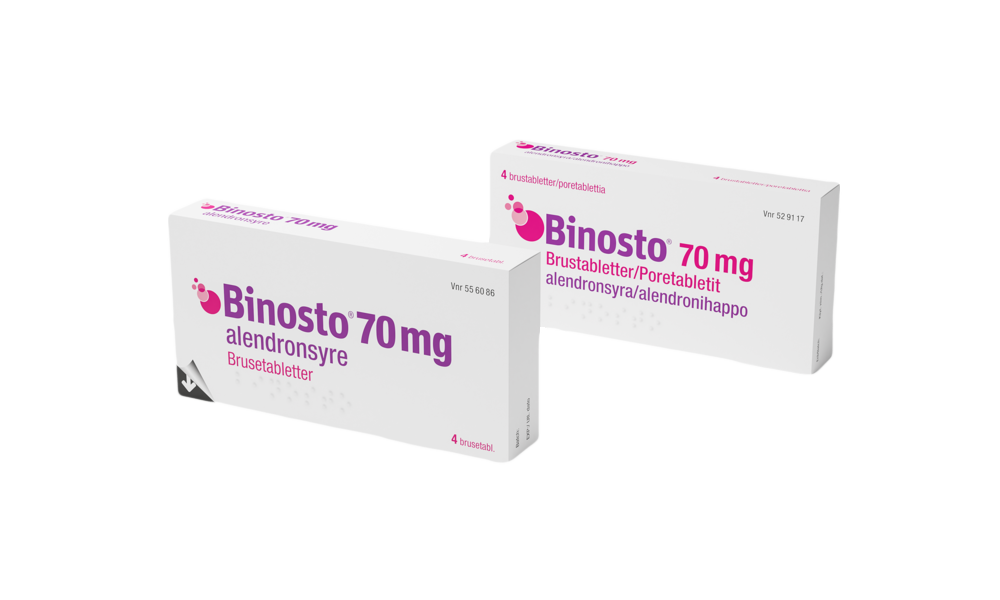Binosto (buffered effervescent alendronate) is an innovative improvement of the golden standard treatment of postmenopausal osteoporosis, alendronate. Osteoporosis, resulting in fractures, causes much suffering, poor quality of life and high societal costs. Norway, Sweden and Denmark are countries with the highest prevalence in the world. However, osteoporosis is highly underdiagnosed and undertreated. Patients which are being treated, most often with alendronate, drop out of treatment to a high extent and few continue throughout the 3-5 years treatment period which is recommended. Binosto has been developed to address issues with plain alendronate tablets and has proven better persistence to treatment. Binosto is available in Denmark and Norway.

Binosto (alendronate effervescent), Tablet, Rx, EF
ATC code
M05BA04
Indication area
Treatment of postmenopausal osteoporosis Reduces the risk of vertebral and hip fractures.
Company
EffRx (Product website)
Last SPC review
2021-06-01
Alendronate can cause local irritation of the upper gastro-intestinal mucosa. In patients with known Barrett’s oesophagus, prescribers should consider the benefits and potential risks of alendronate on an individual patient basis. The risk of severe oesophageal adverse experiences appears to be greater in patients who fail to take alendronate properly and/or who continue to take alendronate after developing symptoms suggestive of 5 II/015 [0039] oesophageal irritation. It is very important that the full dosing instructions are provided to, and understood by the patient. Patients should be informed that failure to follow these instructions may increase their risk of oesophageal problems. Osteonecrosis of the jaw, generally associated with tooth extraction and/or local infection (including osteomyelitis), has been reported in patients with cancer who are receiving treatment regimens including primarily intravenously administered bisphosphonates. A dental examination with appropriate preventive dentistry should be considered prior to treatment with bisphosphonates in patients with poor dental status. While on treatment, these patients should avoid invasive dental procedures if possible. For patients who develop osteonecrosis of the jaw while on bisphosphonate therapy, dental surgery may exacerbate the condition. During bisphosphonate treatment, all patients should be encouraged to maintain good oral hygiene, receive routine dental check-ups, and report any oral symptoms such as dental mobility, pain or swelling. Osteonecrosis of the external auditory canal has been reported with bisphosphonates, mainly in association with long-term therapy. Bone, joint, and/or muscle pain has been reported in patients taking bisphosphonates. In post-marketing experience, these symptoms have rarely been severe and/or incapacitating. The time to onset of symptoms varied from one day to several months after starting treatment. Most patients had relief of symptoms after stopping. bisphosphonate. Atypical subtrochanteric and diaphyseal femoral fractures have been reported with bisphosphonate therapy, primarily in patients receiving long-term treatment for osteoporosis. Causes of osteoporosis other than oestrogen deficiency and ageing or glucocorticoid use should be considered. Hypocalcaemia must be corrected before initiating therapy with Other disorders affecting mineral metabolism (such as vitamin D deficiency and hypoparathyroidism) should also be effectively treated before starting Binosot treatment. Ensuring adequate calcium and vitamin D intake is particularly important in patients receiving glucocorticoids. This medicinal product contains 603 mg sodium per dose equivalent to 30 % of the WHO recommended maximum daily intake for sodium. Binosto is considered high in sodium. This should be particularly taken into account for those patients on a low sodium diet.
Please carefully study the information contained in the leaflet or, as applicable, on the outer packaging.
Please refer to www.fass.se for more information regarding price, more specific warnings etc.
Avia Pharma AB
Birger Jarlsgatan 27
111 45 Stockholm
Sweden